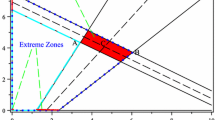In this paper is presented a method for modelling and managing various constraints encountered in task scheduling problems. The approach aims at characterizing feasible schedules through the analysis of the set of constraints and their interaction, regardless of any optimization criteria. This analysis is achieved by a constraint propagation process on a constraint graph and produces both restricted domains for the decision variables and an updated formulation of the initial constraints. The graphs usually used to model temporal constraints seem to be limited because they only allow the representation of strict precedence relations between two tasks. In order to model a larger variety of temporal constraints, particularly any constraint that connects two events (start- or finish- time of a task), a model called a time-bound-on-node (TBON) graph is proposed in which each task is featured by two nodes. Then it becomes possible to handle constraints on task durations, due for example to flexibilities in resource utilization. This kind of graph is not new and has already been investigated in related works on project planning and Constraint Satisfaction Problems. But its processing and interpretation deserved to he developed, particularly for the present purpose, which is the search for the necessary conditions of feasibility. With respect to conjunctive temporal constraints, the analysis is achieved with a polynomial algorithm based on the longest path search on a conjunctive TBON graph, yielding the necessary and sufficient conditions of feasibility. Taking account of resource constraints leads to defining disjunctive constraints. To this end, disjunctive sets of arcs are introduced, making the TBON graph nonconjunctive. In this case, a complete characterization of feasibility cannot reasonably be faced, due to the combinatorial feature. Nevertheless, a polynomial algorithm that applies reduction and deletion rules on the nonconjunctive part of the graph is proposed to restart new propagations on the conjunctive part until all deductions have been made.
Similar content being viewed by others
References
Amamou, M., Happiette, M. and Staroswiecki, M. (1992) Decomposition of the single machine scheduling based on the notion of semi-rigid sub-sequences, in Proceedings of International Conference on Automation Technology, Taiwan, July.
Bartusch, M., Möhring, R. H. and Radermacher, F. J. (1988) Scheduling project networks with resource constraints and time windows. Annals of Operations Research, 16, 201–240.
Bel, G., Bensana, E., Dubois, D., Erschler, J. and Esquirol, P. (1989) A knowledge based approach to industrial job-shop scheduling, in Knowledge-based Systems in Manufacturing, Kusiak, A. (ed.), Taylor & Francis, Basingstoke, pp. 207–246.
Bellman, R. E. (1958) On a routing part problem. Quarterly of Applied Mathematics, 16, 87–90.
Bellman, R., Esogbue, A. O. and Nabeshima, I. (1982) Mathematical Aspects of Scheduling and Applications, Pergamon Press, Oxford, ch. XII.
Carlier, J. and Pinson, E. (1989) An algorithm for solving the job-shop problem. Management Science, 35, 164–176.
Carré, B. (1979) Graphs and Networks, Clarendon Press, Oxford.
Dechter, R., Meiri, I. and Pearl, J. (1991) Temporal constraint networks. Artificial Intelligence, 49, 61–95.
Demeulemeester, E. and Herroelen, W. (1992) A Branch-and-Band procedure for the multiple resource-constrained project scheduling problem. Management Science, 38, 1803–1818.
Dibon, M. (1970) Ordonnancement et potentiels/Méthode M. P.M., Hermann, Paris.
Dreyfus, S. E. (1969) An appraisal of some shortest-path algorithms. Operations Research, 17, 395–412.
Elmaghraby, S. E. (1977) Activity Networks: Project planning and control by network models, John Wiley & Sons, New York.
Elmaghraby, S. E. and Kamburowski, J. (1992) The analysis of activity networks under generalized precedence relations (GPRs). Management Science, 38, 1245–1263.
Erschler, J., Fontan, G. and Roubellat, F. (1979) Potentiels sur un graphe non conjonctif et analyse d'un problème d'ordonnancement à moyens limités. RAIRO Recherche Operationelle,13, 363–378.
Esquirol, P. (1987) Règles et processus d'inférence pour l'aide à l'ordonnancement de taches en présence de contraintes, Thèse de Doctorat de l'Université Paul Sabatier, Toulouse.
Gondran, M. and Minoux, M. (1984) Graphes et algorithmes, Eyrolles, Paris, ch. II.
GOThA (1993) Les problèmes d'ordonnancement. RAIRO Recherche Opérationelle, 27, 77–150.
Graves, S. C. (1981) A review of production scheduling. Operations Research, 29, 646–675.
Kusiak, A. (ed.) (1989) Knowledge-based Systems in Manufacturing, Taylor & Francis, New York.
Lopez, P. (1991) Approche énergétique pour l'ordonnancement de tâches sous contraintes de temps et de ressources, Thèse de Doctorat de l'Université Paul Sabatier, Toulouse.
Montanari, U. (1974) Networks of constraints: fundamental properties and applications to picture processing. Information Sciences, 7.
Roy, B. (1970) Algèbre moderne et théorie des graphes, Dunod, Paris, tome II.
Author information
Authors and Affiliations
Rights and permissions
About this article
Cite this article
Esquirol, P., Huguet, M.J. & Lopez, P. Modelling and managing disjunctions in scheduling problems. J Intell Manuf 6, 133–144 (1995). https://doi.org/10.1007/BF00123685
Issue Date:
DOI: https://doi.org/10.1007/BF00123685




